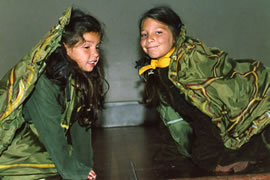African Story Theatre
Program description
Students will create their own African folktale, both in written form and in performance, using sound, stylized movement, music, chants and original dialogue. They will learn and be able to identify the different elements of a drama; character, setting, scene, prop, obstacle, conflict, resolution in the process of creating this story together.

Students will explore the movements of different African animals and do follow up research on their particular abilities using books, pictures, computers, etc.. They will transform the room into an African scene and build their homes in groups. They will make a map of this setting, including the jungle, plains, and watering hole.
As Drama Specialist narrates, students will act out a day in Africa as their animals. Drama Specialist and Teacher will role-play different characters to introduce dramatic conflict into the story. Students will talk about their feelings as the animal and answer questions in character. They will brainstorm solutions to the problem and we will take turns acting out different scenarios. The teacher will take notes on the various ideas and we will then combine all the solutions to come up with one story.
The class will read several African folktales and observe the use of repetition, chants, sounds, and rhythm. We will then write our story as a group incorporating these elements.
Using African storytelling traditions, we will decide how to tell our story dramatically with movement, instruments, chants and call-and-response.
Students can create masks for their characters as a follow-up project. We will then perform our story-play for other classes and parents. Students will each be given a copy of the story in book form to illustrate and take home.
( 5-6 50 minute sessions; K-3.)
Materials needed: name tags, a large open space in a room that also contains desks and chairs (to create the environment), some rhythm instruments.
